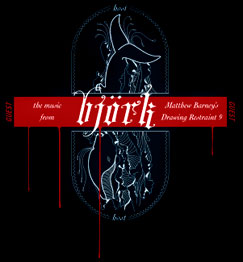Architect and one-time actor Brad Pitt is making a documentary about Frank Gehry and the development of his billowing-skirt residential towers in Brighton, Eng-uh-land.
PITT TO MAKE UK DOCUMENTARY [contactmusic.com, via gutter, the source of that sweet quote above]
Brighton and Hove’s brave new world [bbc]
Previously: How To Tell Me and Brad Pitt Apart
Category: making movies
On The World Losing A Teletype Artist
Jason writes about John Sheetz, a longtime HAM and a Teletype artist [who knew? which is precisely the point] he interviewed in 2003 for his BBS Documentary, and who passed away last January.
How many life’s works are biding time in cluttered New Jersey garages, forgotten by nearly all but their creators–and sometimes, even by them?
A Silent Key [textfiles.com, via waxy]
What Coudal’s Doing On Their Summer Vacation
Making a “short feature film,” just for the heck of it, it turns out, and documenting the production online:
The very first thing that happened is that we dropped an expensive rented audio remote unit down three flights of stairs. Oops. I wonder if Kubrick had to take a conference call about an advertising project after finishing just three set-ups on the first day of shooting Barry Lyndon?
Check it out: Copy Goes Here [coudal.com]
Robert Melee? He Has A Huge Talent Show
A couple of snaps from Robert Melee’s Talent Show at The Kitchen. With touches of Wigstock, Laugh-in, Blow-up, Moulin Rouge, Merce, Cher, Olivia Newton John fitness video, Puppetry of the–um–and Fischerspooner-meets-Spinal Tap, it’s a NSFW riot.
And don’t forget Robert’s mother. As if you ever could. There’s one more performance, Thursday night at 8. If tickets are available, you should get them.
Robert Melee’s Talent Show 6/30, 8p [thekitchen.org]
Mad Hot Clearances
Once again, a highly acclaimed documentary is nearly wrestled to the ground by the exorbitant cost of clearing the rights to music–including a ringtone–that appears in the film. Not talking about the soundtrack here, either, but the diagetic (i.e., in-story, on-camera) sound that permeates the real world where the filmmakers shot.
This time, it’s Mad Hot Ballroom, directed by Marilyn Agrelo and produced by Amy Sewell. The filmmakers spent $140,000, 45% of their budget, to clear the rights. Stay Free! interviewed Sewell about the IP challenges they faced, which went well beyond the music:
Well, we had to watch out for billboards and Frito-Lay trucks all the time. But I usually didn’t care, we would just shoot. The biggest danger with clearances is when they interfere with documenting real life. Something spontaneous like a cell phone ringing is different than a planned event. If filmmakers have to worry about these things, documentaries will cease to be documentaries! What happens when the girls go shopping and there’s music playing in the stores? We were lucky because in our movie the music wasn’t identifiable, but otherwise what are we supposed to do: walk up to the store manager and say, “Excuse me but can you turn off your radio?”
That sucks. Of course, we say that all the time when we go into stores. It can be an audio pain to edit a scene with a song playing through it.
How did Mad Hot Ballroom survive the copyright cartel? [stay free! via waxy]
Previously: Clearing Tarnation cost approximately 2,200 times that film’s $218 production budget.
Young, Dumb, and Full Of Coke

You have to admit, she does look rather mannish.”
For a brief moment in the early 90’s, The Modern Review was really good, almost a smarter, smugger Spy, if such a thing can be imagined. Then it started to turn in on itself, then it imploded in a brawlful of recriminations between its two egomaniacal founders Julie Burchill and Toby Young [who both happened to bed the magazine’s soap-operatically named would-be-usurper/editrix Charlotte Raven] and then–jump forward ten years so I don’t have to recount the whole annoying Vanity Fair Toby Young saga again, thank you–well, and then Monday at 9PM GMT, Mark Halliley’s documentary about the coke-fuelled rise and fall of MR airs on BBC4.
From his account of the making of in the MediaGuardian, the whole show is a bunch of self-absorbed liars and cokeheads in various stages of denial and/or sobriety who continue bitching about each other instead of doing something more productive with their once-promising talents. Which sounds about right. Enjoy.
[And this, from someone who counts Toby as a friend of two different friends.]
Julie and Toby in the hall of mirrors [mediaguardian.co.uk]
I Cut Thigh With A Little Help From My Flense
 For the first time, Matthew Barney and Bjork have collaborated on a film and soundtrack called Drawing Restraint 9, after some of Barney’s earliest, pre-Cremaster works. In DR9, the two visit a Japanese whaling ship in Nagasaki, undergo various Shinto wedding-inspired rituals, form and reform a large Vaseline sculpture, and then themselves transform into whales by cutting each others feet and legs off with flensing knives.
For the first time, Matthew Barney and Bjork have collaborated on a film and soundtrack called Drawing Restraint 9, after some of Barney’s earliest, pre-Cremaster works. In DR9, the two visit a Japanese whaling ship in Nagasaki, undergo various Shinto wedding-inspired rituals, form and reform a large Vaseline sculpture, and then themselves transform into whales by cutting each others feet and legs off with flensing knives.
Bjork’s soundtrack incorporates Japanese instruments, vocalizations, and both folk and court music traditions.
[No, I didn’t know, either. Flensing is the process of cutting strips of blubber off of a whale carcass, as in Moby Dick, or this 1970 National Geographic photograph of a flensing Icelandic whaler.]
No word yet on when/where this will be released. The film premieres July 1 along with an exhibit of Barney’s work at the 21st Century Museum in Kanazawa, Japan, and the cd comes out later that month. I love that a museum with this name still follows the antique Japanese corporate tradition of requiring postcard requests for seats. [kanazawa21.jp, via pitchfork]
Drawing Restraint 9 [bjork.com, via kottke, archinect]
On PT Anderson’s Use of Color
The latest issue of Senses of Cinema includes Cubie King’s intriguing look at PT Anderson’s use of color in Punch-Drunk Love. In addition to the interstitial abstract animations by artist Jeremy Blake [which were originally meant to represent–is that too strong a word?–Adam Sandler’s character’s state of mind], King cites Anderson’s recurring, particular use of red, white, and blue, and his inclusion of in-camera effects like washout lighting and lens flares. That’s a lot.
King asserts that Anderson truly comes into his own in P-DL. But I recently rewatched Magnolia, and yeah, it’s Altman-esque in its structure, but damn, that is one uniquely intense film. Tom Cruise is actually good, unnervingly so, [although the schtick gets tired when he tries it for real on Oprah; suspension of disbelief, my butt] and Julianne Moore, wow, what a sustained performance. Macy, too, now that I think about it.
FYI, Blake’s latest trilogy of video work, Winchester moves to incorporate more representational and narrative elements than before. It’s showing at SFMOMA through October 10. P-DL screens June 12 at the Museum as the last of a damn-I-missed-it Blake-curated film series.
Punch-Drunk Love: The Budding of an Auteur [sensesofcinema.com]
Winchester, by Jeremy Blake [sfmoma.org]
Buy the Punch-Drunk Love 2-disc edition DVD or this sweet little Winchester exhibition catalogue [amazon.com]
Who Makes Movies? Well, Fluffers, For One.
Personally, every time I see those “Who Makes Movies?” spots where some lowly crew member is trotted out to say how Internet pirates are taking food out of his dyslexic kid’s mouth, I want to say, “Actually, it’s Canadians who are taking your job, pal, thanks to the studios moving over $10 billion worth of production-related economic activity out of the US in pursuit of lower wages, more pliable unions, and government-funded tax incentives. Oh, and they’re the same studios who are funding these MPAA commercials and claiming that “potential worldwide losses” from “piracy” “could” exceed $3 billion a year.
Needless to say, the folks behind these three spoof spots have a funnier time of it.
Check out “Zombies make movies,” “Script doctors make movies,” and “Fluffers make movies” at R4NT Magazine. [R4NT.com, via boingboing]
Yeah, but who makes points on gross? [lowculture.com, 11/03, yes, this whole MPAA thing is getting old.]
Film & Television Action Committee [ftacusa.com]
Edward Jay Epstein, Hollywood Accountant
Move over, Harvey Birdman, Attorney at Law.
In his article in Slate, “Paranoia for Fun and Profit: How Disney and Michael Moore cleaned up on Fahrenheit 9/11”, Epstein shows how Moore played up Disney’s refusal to distribute his Cannes-winning doc, and how Disney happily extracted some serious participation–they netted $75 million of the film’s $228 million worldwide box office, plus another $3mm for DVD royalties– from the distributors they “sold” it to.
Given Disney’s ongoing interest F9/11‘s performance, it sounds more accurate, if not technically true, to say they didn’t “sell” the film, so much as they outsourced distribution.
But Epstein’s talking about the accounting world’s reality, where, as he’s written previously, Hollywood studio films are all German productions now.
As for Moore, he made at least $27 million, not counting what he may have pocketed for producing the film itself (Epstein notes that it cost far less to make than the $6 million Miramax fronted for production, not including Moore’s acting, producing, writing, and directing fees. [Of course, clearing the music could’ve eaten up that much, too, so who can say?])
Next on Epstein’s list (I hope): “Sadistic Religiosity and Jew-baiting for Fun and Profit: How, verily, Mel Gibson got is reward from The Passion”
Socks, Fries & Videotape
The Guardian reports that Steven Soderbergh’s new series of HD films will be released by Mark Cuban’s and Todd Wagner’s 2929 Entertainment simultaneously in the company’s theaters, on their HD TV channel, and on DVD. Given the reach of the channel and the market for an unknown DVD, my guess is the initial buzz and revenue will still come from theatrical, but those ratios will change over time, both as the release and the series plays out and as more titles have multi-channel releases.
A couple of weeks ago, I’d read somewhere (?) that Soderbergh was casting the film’s non-actors by cruising malls and fast food restaurants in Ohio, looking for people with the right look. Of course, Gus Van Sant did this for Elephant, too, but he only went to A&F.
Soderbergh’s revolution [guardian.co.uk, via kottke]
Related: The Cuban Revolution [wired mag]
The Wagner Revolution [oh wait, no. Xeni?]
[5/5 update: Guess she doesn’t read the blogs, but now that it’s been in THR, Xeni namechecks the story, adding some transcript from her Cuban interview.]
Daddy, Tell Me A Back Story
The problem is that Penn can’t play just any agent trying to do his job. He has to have his own traumatic back story and overflowing well of grief over a dead wife, because what’s a Penn performance these days without the actor emoting in close-up for a camera frozen in awe? (You can practically hear the director say, “And now, ladies and gentleman, the stylings of the premier actor of his generation.”)
…
After all, [Kidman] has a back story of her own…
In the true spirit of diplomacy, Edelstein lets both the director and the writers have it in his Slate review of The Interpreter.
Lost in Translation [slate]
From The Two Ends Of The Online Viewing Spectrum
 Never the innovator, apparently, NEC commissioned a series of sponsored short films which debuted last fall. The theme(s)? “Ubiquitous” and “U Can Change.” Let me just say, that slogan’s no “Art of Speed.” I guess they think it works alright in Japanese.
Never the innovator, apparently, NEC commissioned a series of sponsored short films which debuted last fall. The theme(s)? “Ubiquitous” and “U Can Change.” Let me just say, that slogan’s no “Art of Speed.” I guess they think it works alright in Japanese.
Anyway, Venice, CA punk agency 86 the Onions produced a batch, which look to me like Western parodies of nonsensical Japanese commercials. “Cocoon” or “Karaoke” are probably the best, although the latter’s too long. My favorite is “Wedding”; it’s got a smart surprise ending. [Reading the making of story at adland, no one’ll be surprised to learn they came up with the ideas in 24 hours, and shot them in like a week. I hope they got paid a fortune.]
Meanwhile, the trailer’s online for Lars von Trier’s Manderlay. Hmm? Something about slavery? Whatever, it’s a shoe-in for La Palme d’Feelgood at Cannes.
adland: 86 the onions make ubiquitous campaign for NEC Japan [ad-rag.com]
Shorts for NEC Ubiquitous, by 86 the Onions
Lars von Trier’s Manderlay [play.dk, via robotwisdom]
Smells Like Cine Spirit
Gus Van Sant’s new film, Last Days, is a fictional recreation of the impending death of Kurt Cobain, shot in the director’s now-mature semi-documentary style.
The trailer’s up; Last Days opens May 16 in France, timed, presumably, with its debut at Cannes. Don’t feel bad that France gets to see it long before the US, though. After all, Gerry didn’t come out in France until after Elephant.
Last Days trailer [allocine.fr, via mefi]
a fluffy Cobainiac take on the movie [mtv.com]
Tomorrow Night at MoMA: An Evening With Marc Forster
Some of you have already gotten this in email, but tomorrow night (Tuesday, 4/12) is the fourth annual installment of A Work In Progress, where MoMA’s Film & Media department celebrates a distinct directorial voice in cinema.
This year’s honoree is Marc Forster who will be talking with legendary post-structuralist film scholar Will Ferrell about his work (Finding Neverland, Everything Comes Together, that scene in Monster’s Ball). There will be many celebrity guests [not counting me; I’ll be working it so hard, you couldn’t call me a guest], which I’m pretty sure means Johnny Depp and Heath Ledger doing their infamous mashup skit, Finding Balls. No idea what that means.
Here’s a pdf [300k] of the invite, or you can call MoMA’s Special Events office: Tel. (212) 708-9680, fax (212) 708-9429, specialevents@moma.org.
Tickets:



